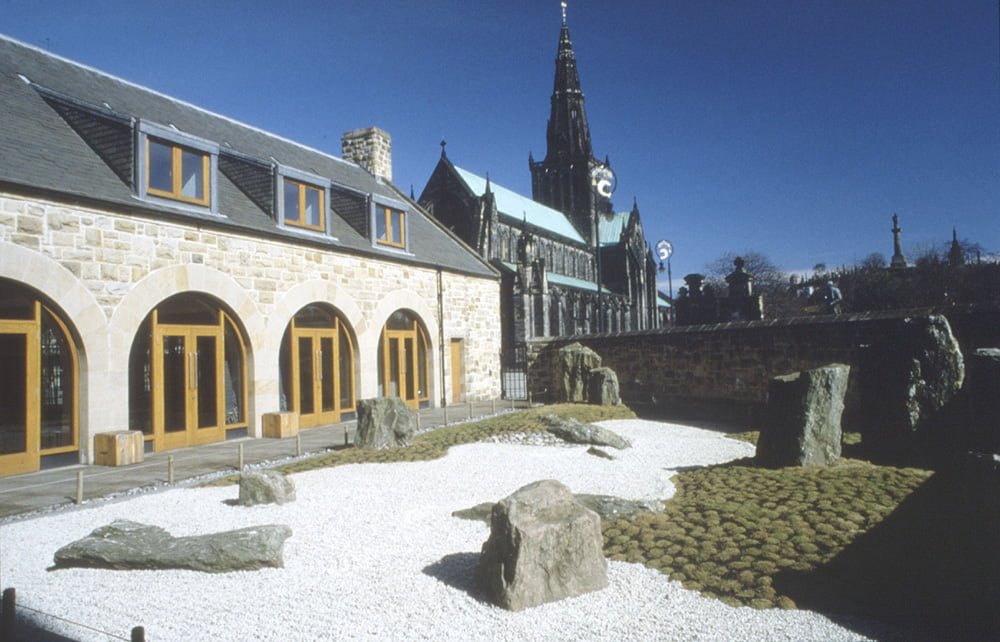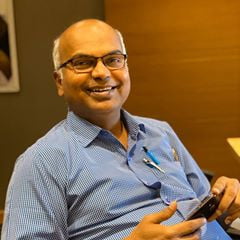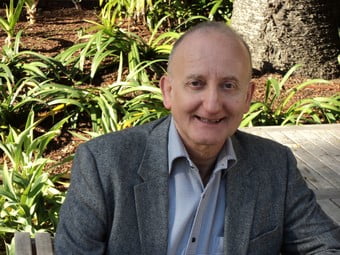The St Mungo Museum
by Sr Isabel Smyth SND
 The St Mungo Museum of Religious Life and Art is a very special place. It’s named after Glasgow’s patron saint who brought the Christian faith to Scotland in the 6th century and designed in the style of the medieval Bishops’ Castle on which site it’s built. When it was opened in 1993 it was one of only two museums of religions in Europe though there were Christian monasteries and churches that had been converted into or housed displays of religion. What made St Mungo’s different was that it included all religions and none and in the 1990s this wasn’t very popular especially with the Christian Churches, many of whom had a theology of believing they had an exclusive insight into truth and salvation and weren’t at all sure about displaying artefacts from ‘non-christian’ faiths. What challenged many of them was that the Gallery of Religious Life showed that all faiths celebrated, ritualised, and customised significant moments in life – birth, initiation, commitment, marriage, death. The displays honoured the integrity of each faith but showed their similarities. I delighted to see statues of the Virgin Mary with her son Jesus next to the Goddess Isis with her son Horus in exactly the same pose, or the infant Jesus next to the infant Krishna. This did annoy some people, but part of interfaith work is to realise that all want to celebrate significant rites of passage and that there are universal symbols and commonalities in the way they do this. It should also be said of course that it attracted a lot of praise and recognition for being ground-breaking and innovative and for significant artefacts like the statue of Siva Nataraja and the first authentic zen garden in Britain.
The St Mungo Museum of Religious Life and Art is a very special place. It’s named after Glasgow’s patron saint who brought the Christian faith to Scotland in the 6th century and designed in the style of the medieval Bishops’ Castle on which site it’s built. When it was opened in 1993 it was one of only two museums of religions in Europe though there were Christian monasteries and churches that had been converted into or housed displays of religion. What made St Mungo’s different was that it included all religions and none and in the 1990s this wasn’t very popular especially with the Christian Churches, many of whom had a theology of believing they had an exclusive insight into truth and salvation and weren’t at all sure about displaying artefacts from ‘non-christian’ faiths. What challenged many of them was that the Gallery of Religious Life showed that all faiths celebrated, ritualised, and customised significant moments in life – birth, initiation, commitment, marriage, death. The displays honoured the integrity of each faith but showed their similarities. I delighted to see statues of the Virgin Mary with her son Jesus next to the Goddess Isis with her son Horus in exactly the same pose, or the infant Jesus next to the infant Krishna. This did annoy some people, but part of interfaith work is to realise that all want to celebrate significant rites of passage and that there are universal symbols and commonalities in the way they do this. It should also be said of course that it attracted a lot of praise and recognition for being ground-breaking and innovative and for significant artefacts like the statue of Siva Nataraja and the first authentic zen garden in Britain.
When the museum was being set up the curators worked hard to involve stakeholders and be inclusive of all faiths. Through the Glasgow Sharing of Faiths, faith communities were kept informed of developments, were consulted about the displays, and even contributed to them. Because of this the various faith communities felt they had an investment in the museum. In a very special way, it felt like home to them, and was used to celebrate festivals and events like the exhibition on the Declaration Towards a Global Ethic which was brought to Glasgow by Hans Kung who had presented it and had it accepted at the Parliament of World Religions in 1993, the same year the museum opened. But above all the museum became a centre for interfaith activity.
 The mission statement of St Mungo’s says that it is designed to ‘explore the importance of religion in people’s everyday lives across the world and across time, aiming to promote mutual understanding and respect between people of different faiths and none’. As an interfaith practitioner I’ve had a lot to do with the museum and been greatly supported in my work by the curator, manager and staff. For about fifteen years we hosted an annual Meet Your Neighbour event which happened over a weekend but took an interfaith committee many months to plan. Different religious communities set up a display of their faith in the function room and were available to meet and talk to visitors. The weekend was punctuated by musical or cultural events, like the Jewish Choral Society, Hindu dancers, bellringers, tabla and sitar players. We had workshops on storytelling, sari wearing. Mehndi, calligraphy. We involved schools and on occasions when we decided on a concert on the Sunday afternoon, we had people standing by the zen garden with the doors and windows open so that they could hear the concert as there were no seats left in the function room. Sometimes the dialogues were of a more serious nature and in the run up to the reconvening of the Scottish Parliament in 1999 it was where members of faith communities gathered to consider what the New Scotland would be like for people of faith.
The mission statement of St Mungo’s says that it is designed to ‘explore the importance of religion in people’s everyday lives across the world and across time, aiming to promote mutual understanding and respect between people of different faiths and none’. As an interfaith practitioner I’ve had a lot to do with the museum and been greatly supported in my work by the curator, manager and staff. For about fifteen years we hosted an annual Meet Your Neighbour event which happened over a weekend but took an interfaith committee many months to plan. Different religious communities set up a display of their faith in the function room and were available to meet and talk to visitors. The weekend was punctuated by musical or cultural events, like the Jewish Choral Society, Hindu dancers, bellringers, tabla and sitar players. We had workshops on storytelling, sari wearing. Mehndi, calligraphy. We involved schools and on occasions when we decided on a concert on the Sunday afternoon, we had people standing by the zen garden with the doors and windows open so that they could hear the concert as there were no seats left in the function room. Sometimes the dialogues were of a more serious nature and in the run up to the reconvening of the Scottish Parliament in 1999 it was where members of faith communities gathered to consider what the New Scotland would be like for people of faith.
It was in the light of these discussions that the Scottish Interfaith Consultative Group was formed and this then led to the setting up of the Scottish Interfaith Council which today is known as Interfaith Scotland. The Council was started with very little – myself as the founding director, the gift of a computer from my community and the use of an office in St Mungo’s. This consolidated the relationship between the Museum and SIFC and we continued to work well together. For us St Mungo’s became the home to our dialogues with First Ministers, religious leaders, interfaith practitioners from England, Ireland, and Wales. It’s where we grew and developed. We eventually had to move out when we got funding to appoint staff and even then we were given an office by Glasgow Life, the body that runs Glasgow Museums. And continued to work together especially in projects such as the setting up of the Forum of Faiths by Glasgow City Council.
I think it’s obvious that St Mungo’s Museum is very close to my heart and I hope it’s obvious that it has fulfilled its mission well and contributed positively to the social fabric of Glasgow. So, I am appalled and dismayed that there is some likelihood that it might not open after the pandemic. The suggestion that the Council is looking to transfer the museum to a third party is worrying. St Mungo’s is unique, it has made a significant contribution to overcome racism, sectarianism and religious prejudice. It has worked with faith communities, school children and others to promote mutual understanding, respect and cooperation. It has involved stakeholders in a way no other museum has and to shut it would be a disgrace as far as I am concerned. It’s something that must be contested.
The St Mungo Museum Read More »



 Fr Victor Edwin is a Jesuit priest who teaches Christian-Muslim Relations at Vidyajyoti, a Catholic centre for higher theological learning in Delhi. He is deeply engaged in seeking to promote understanding and goodwill between Christians and Muslims. He has a PhD in Islamic Studies from Jamia Millia Islamia, New Delhi, and has written widely on issues related to interfaith relations.
Fr Victor Edwin is a Jesuit priest who teaches Christian-Muslim Relations at Vidyajyoti, a Catholic centre for higher theological learning in Delhi. He is deeply engaged in seeking to promote understanding and goodwill between Christians and Muslims. He has a PhD in Islamic Studies from Jamia Millia Islamia, New Delhi, and has written widely on issues related to interfaith relations.

 Guest blog – Cardinal Michael Czerny reflects on the significance of the first International Day of Human Fraternity marked on Thursday, in this reflection which is reposted from
Guest blog – Cardinal Michael Czerny reflects on the significance of the first International Day of Human Fraternity marked on Thursday, in this reflection which is reposted from 
 It is impossible to conceive of any religion that doesn’t include some concept of pilgrimage. Islam makes it one of the Five Pillars to its religion – the Hajj. Every adult Muslim is expected to make this journey at some point in their life, even if only by great difficulty. The Holy site of Mecca is itself rather illusive, despite being at the centre of this rite. It’s Ka’bah is popularly considered to have been built by Adam, and to have been re-built by Abraham. These legendary associations transform this figurative “House of God” into a focal-point for all Humanity, in the first instance, and then into an Abrahamic shrine. Pilgrimage to Mecca thereby accomplishes, for Muslims, a return to their source (Allah) and to the foundation of His relationship with Humanity. They fulfil religious obligation in making a journey of prayer to this site, and return home uplifted. For Jews and Christians both, Jerusalem is the central space by contrast (Muslims make a secondary pilgrimage there nonetheless). By Biblical narrative, this city was the site upon which God blessed Abraham – through Melchizedek, its King – and upon which His Chosen Nation was founded centuries later. In the New Testament, it was the city in which Jesus Christ was to be suffer His Passion, Death, Resurrection and Ascension. It was also the city in which Pentecost was to come, and from which the Gospel would leave to reach the ends of the earth. So that, in making pilgrimage to Jerusalem, there are again the two key notions of returning to a Divine source and leaving rejuvenated by that source, to bring its joy to others.
It is impossible to conceive of any religion that doesn’t include some concept of pilgrimage. Islam makes it one of the Five Pillars to its religion – the Hajj. Every adult Muslim is expected to make this journey at some point in their life, even if only by great difficulty. The Holy site of Mecca is itself rather illusive, despite being at the centre of this rite. It’s Ka’bah is popularly considered to have been built by Adam, and to have been re-built by Abraham. These legendary associations transform this figurative “House of God” into a focal-point for all Humanity, in the first instance, and then into an Abrahamic shrine. Pilgrimage to Mecca thereby accomplishes, for Muslims, a return to their source (Allah) and to the foundation of His relationship with Humanity. They fulfil religious obligation in making a journey of prayer to this site, and return home uplifted. For Jews and Christians both, Jerusalem is the central space by contrast (Muslims make a secondary pilgrimage there nonetheless). By Biblical narrative, this city was the site upon which God blessed Abraham – through Melchizedek, its King – and upon which His Chosen Nation was founded centuries later. In the New Testament, it was the city in which Jesus Christ was to be suffer His Passion, Death, Resurrection and Ascension. It was also the city in which Pentecost was to come, and from which the Gospel would leave to reach the ends of the earth. So that, in making pilgrimage to Jerusalem, there are again the two key notions of returning to a Divine source and leaving rejuvenated by that source, to bring its joy to others. In the tradition of Hinduism, the ancient city of Varanasi holds especial significance for pilgrimage. Within its boundaries is the sacred river Ganges, which is of great importance to most Hindus, as a river in which they might wash away their sins. The city itself was reputedly founded by Shiva, who beheaded his rival Brahma. Brahma’s head was lost by Shiva, and fell into the ground, therefore making the land encompassed by Varanasi absolutely sacred in Hindu belief. Varanasi is crucial also to many Buddhists – the Gautama Buddha having given his first sermons not far from the centre of the city, at Sarnath. For Sikhs, there is the city of Amritsar, which hosts the Golden Temple. The city’s name translates as “Pool of the Nectar of Immortality” – returning us to the theme of a space’s power to transform us from within – and it was founded alongside the temple by Guru Arjan.
In the tradition of Hinduism, the ancient city of Varanasi holds especial significance for pilgrimage. Within its boundaries is the sacred river Ganges, which is of great importance to most Hindus, as a river in which they might wash away their sins. The city itself was reputedly founded by Shiva, who beheaded his rival Brahma. Brahma’s head was lost by Shiva, and fell into the ground, therefore making the land encompassed by Varanasi absolutely sacred in Hindu belief. Varanasi is crucial also to many Buddhists – the Gautama Buddha having given his first sermons not far from the centre of the city, at Sarnath. For Sikhs, there is the city of Amritsar, which hosts the Golden Temple. The city’s name translates as “Pool of the Nectar of Immortality” – returning us to the theme of a space’s power to transform us from within – and it was founded alongside the temple by Guru Arjan.





